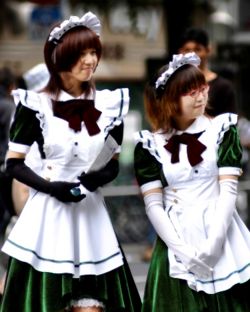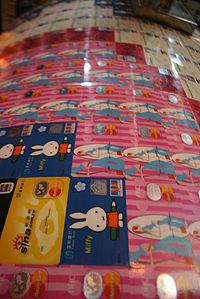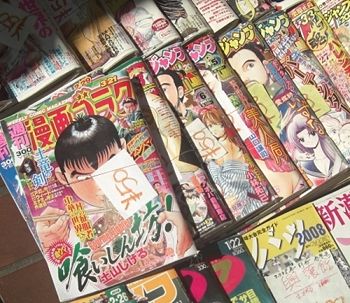Japanese popular culture

Photo © by Sonny Santos, used by permission.
Japanese popular culture is a highly distinct collection of fashions, art, music and other forms of expression, appearing in both mainstream society and underground subcultures. While some examples of these are widely known in the West, such as cinema's Godzilla monster, many today are either unique to Japan or mainly influence contemporary Asian popular culture.
Popular culture in Japan is very much the mainstream; while ancient sites are easy to find, the Japanese are rarely seen practising traditional arts such as ikebana (活花, 'flower arranging'). Cartoons, comics and above all, anything kawaii (可愛い, 'cute') are strong influences on high-tech products and clothes available in the high street, as well as teenage and children's fashions. While young Japanese often follow overseas trends, they have also developed their own trendy subcultures that to outsiders may border on the bizarre - young people dressed in maid outfits or in cute Victorian-style 'Lolita' costumes are more common a sight in Tokyo than traditionally-dressed maiko (妓) girls in historic Kyoto. These trends come and go, reported by the huge media industry, and also find a home in the more seedy areas of Japanese society. Template:TOC-right
Cuteness
Much of mainstream Japanese society conforms to the idea that goods and lifestyle decisions should be kawaii (可愛い, 'cute'). Baby-faced cartoons such as Pokémon (ポケットモンスター, Poketto Monsutā 'Pocket Monster') and small gadgets, often pink, are perhaps the best examples of this phenomenon, which is thought to be rooted in the rise of a Japanese consumer society in the 1970s, and also through the encouragement of dependent social relationships and the need to escape a highly stratified society.[1] Many adults adore cuteness as much as children and teenagers: for example, bank cards are available with cute cartoon characters printed on them, and though the culture of kawaii is most firmly established among young girls, grown men are prepared to be seen with cute items too. The prevalence of kawaii has led to criticism both within and outside Japan, depicting its society as one of increasing infantilisation; such goods tend to be popular with non-Japanese children but have yet to make inroads among foreign adults.[2] To a greater or lesser extent, each of the themes discussed below involves an appreciation of cuteness in some way.
Media
Japan is a nation of avid newspaper and magazine readers. About 92% of households subscribe to a morning newspaper, and the Japanese apparently consider print media to be the most reliable way to get their news. Newspaper circulation, with about 630 people to every thousand copies in the country, is significantly ahead of other nations,[3] including the USA[4] and the UK. News reporting ranges from serious political stories to the latest celebrity gossip, with the lives of these 'idols' detailed in popular magazines as well as on-line. Newspapers and the government often make use of comics (manga, 漫画 'comic') to put across important issues to people of all ages.[5] The biggest-selling newspapers are the right-wing Yomiuri Shimbun (読売新聞) and the left-leaning Asahi Shimbun (朝日新聞),[6] while one of most widely read magazines is FRUiTS, a monthly guide to street fashion.[7]
'Idols'
Japanese media extensively covers celebrity news, particularly the activities of aidoru (アイドル, 'idol'). Typically well-promoted female singers or supporting actors, their media lives are often short-lived, usually because they are selected mainly for their youth and cute looks rather than obvious talent. While occasionally idols such as Aya Sugimoto (杉本彩, Sugimoto Aya) continue to appear in the press for some time, often due to controversies in their personal lives, a few of them stay around long enough to influence a new fashion or craze, and even go on to become mainstream performers. For example, the singer Kumi Koda (倖田來未, Kōda Kumi), who has enjoyed success in the music charts for several years, is also associated with the fashion for hot pants, and the singer and actress Kyoko Koizumi (小泉今日子, Koizumi Kyōko) has been around in a variety of guises since the heyday of idols in the 1980s.[8]
Manga
One of the most popular forms of entertainment in Japan is manga (漫画), meaning 'comic' or 'cartoon'; in recent years, Japanese-style comics have also become more popular overseas, and the word is now firmly established in the English language to refer to these. From a Western perspective, manga appear similar to the more adult-orientated graphic novel, but in Japan they are read by people of all ages, and also serve as an interesting way of getting the news: government ministries as well as corporations have often used manga to put across complicated ideas to the public.[9] Typically, they are printed in black and white, and as is the case with much other Japanese reading matter, are read from right to left, starting from the 'back' of the book. Manga fans can be seen reading their favourite stories in 24-hour convenience stores or with coffee in special round-the-clock 'manga cafés' (漫画喫茶 or マンガ喫茶, manga kissa). Another place to find the legions of manga readers is at the three-day 'Comic Market' (コミック・マーケット Komikku Māketto) in Tokyo, Japan's largest public indoor gathering; at this magazine fair a vast number of manga are available to browse and buy.[10]
Manga stories cover all kinds of adventures, with four creations particularly well-known: the robot-child Astro Boy (or Mighty Atom, i.e. 鉄腕アトム Tetsuwan Atomu); the independently-minded lady Sazae-san (サザエさん); the time-travelling mechanical cat Doraemon (ドラえもん); and Black Jack (ブラック・ジャック), the tale of an underworld surgeon who performs implausible operations to save the innocent. The artist Osamu Tezuka (手塚 治虫 Tezuka Osamu) became known as the 'God of Manga' for giving the world Astro Boy in 1952,[11] and was also responsible for developing Black Jack in the 1970s. Machiko Hasegawa (長谷川町子 Hasegawa Machiko), creator of Sazae-san, was also one of the first female manga artists. Doraemon has been thrilling readers since 1969, and these adventures have been the recipient of several awards, including Asahi Shimbun's 'Tezuka Osamu Cultural Prize' (手塚治虫文化賞, Tezuka Osamu Bunkashō) in 1997. The cat was also recognised by Time Asia magazine in 2006 as an 'Asian Hero', or cultural icon.[12]
Film, television and video games
Television
Television personalities
Video games
Pokémon
Anime
Technology
Internet
Virtual characters
Robots
Purikura
Going out

Photo © by Sonny Santos, used by permission.
'Water trade'
Hostess bars
Karaoke
karaoke (カラオケ, 'empty orchestra')
Pachinko
Theme parks
Fashion and subcultures

Photo © by Sonny Santos, used by permission.
Office workers
Cosplayers
Otaku
Crazes
Relationships
Love hotels
Gay Japan
Sex industry
Soaplands
Enjo kōsai
Footnotes
- ↑ Garger (2007).
- ↑ e.g. Kerr (2002:312).
- ↑ Yomiuri Shimbun (2008): 'Japanese newspapers have stable readership'.
- ↑ In the USA, readers have moved to online news sources over print media in recent years. See USA Today: 'Newspaper circulation off 2.6%; some count Web readers'. 5th November 2007. This was also true in the 1950s: see Time: 'Record Press Run'. 21st May 1956.
- ↑ See Kinsella (2000) and the manga section below.
- ↑ See Yomiuri Shimbun (2008), above.
- ↑ STREET/FRUiTS/TUNE - official English website.
- ↑ Internet Movie Database: 'Kyôko Koizumi'.
- ↑ Kinsella (2000). For a controversial example of the use of manga to explain defence policy, see Mainichi Daily News: 'Defense Ministry turns to 'Lolita' manga character to reveal inner self'. 24th July 2007.
- ↑ Comiket.co.jp: 'What is the Comic Market?'. Official information from the organising committee.
- ↑ Schodt (2007).
- ↑ Time Asia: 'The Cuddliest Hero in Asia'. 2006.

